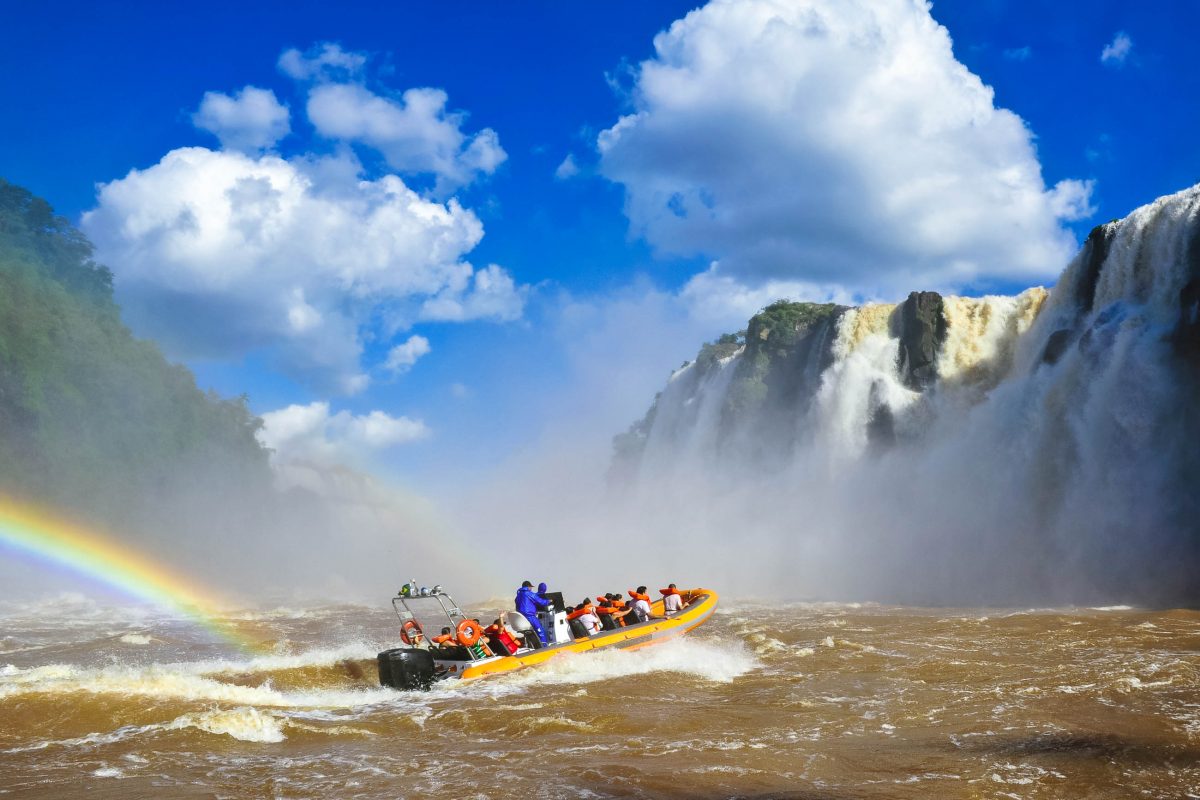Die atemberaubenden Iguaçu Fälle zwischen Brasilien und Argentinien sind die breitesten Wasserfälle der Welt. Auf einer Ausdehnung von knapp 3km donnern die enormen Wassermassen bis zu 80m in die Tiefe.
Kennt ihr die Niagara-Fälle zwischen und USA und Kanada? Sie sind beinahe mickrig gegen das, was Argentinien und Brasilien zu bieten haben! Die Iguaçu Wasserfälle im gleichnamigen Nationalpark gehören zu den größten Wasserfällen weltweit und halten mit fast 3 Kilometern Ausdehnung definitiv den Rekord des breitesten Wasserfalls der Erde.
Die spektakulären Fälle stehen auf unseren Listen der Top 10 Sehenswürdigkeiten von Brasilien und Argentinien und gehören zu unseren 10 schönsten Wasserfällen der Welt.
Die Bezeichnung „Iguaçu“ kommt aus dem Guaraní, der offiziellen Amtssprache von Bolivien und Paraguay, und bedeutet „großes Wasser“. Der Sage nach soll der eifersüchtige Schlangen-Gott Boi auf der Suche nach einer fliehenden Jungfrau diese Schlucht ins Flussbett des Iguaçu geschlagen haben.
Inhaltsverzeichnis
BILDER: Iguaçu Wasserfälle
Fotogalerie: Iguaçu Wasserfälle in Brasilien und Argentinien
Iguaçu Wasserfälle: Enorme Zahlen

Auf 2700 Meter Breite stürzen die Wassermassen inmitten einer einzigartigen Urwaldkulisse bis zu 80 Meter in die Tiefe. Insgesamt kann man mehr als 250 Wasserfälle zählen. Diese Zahl schwankt, da sie vom Wasserstand des Zulieferflusses Iguaçu abhängig ist. Den Höhepunkt der Wasserfälle bildet der Teufelsschlund. Dieser ist 700 Meter lang und 150 Meter breit.
Bezüglich der Wassermenge, welche pro Sekunde bei den Wasserfällen hinunterjagt, gehen die Meinungen auseinander. Hier werden bis zu 13.000 Kubikmeter Wasser pro Sekunde angegeben.
Die unterschiedliche Schreibweise „Cataratas do Iguaçú“ (portugiesisch) und „Cataratas del Iguazú“ (spanisch) liegt übrigens daran, dass die Staatsgrenze zwischen Brasilien und Argentinien mitten durch sie hindurch verläuft.
Besuch der Iguaçu Fälle – welche Seite ist die Beste?

Die Iguaçu Wasserfälle können von der brasilianischen und argentinischen Seite aus bewundert werden. Etwa zehn Prozent der Iguaçu Wasserfälle befinden sich auf brasilianischer Seite. Die Brasilianer sind nicht traurig darüber, weil sie eine fantastische Aussicht auf die argentinische Seite der Iguaçu Wasserfälle haben. Deshalb ist die brasilianische Seite die bessere Wahl, um die Iguaçu Wasserfälle zu besichtigen.
Wenn ihr die Wasserfälle allerdings weniger im Überblick, sondern hautnah erleben wollt, solltet ihr euch für die argentinische Seite entscheiden. Dschungelpfade führen euch ganz nah heran und ihr könnt dem 80 Meter tiefen Teufelsschlund direkt ins Maul schauen.
Am spektakulärsten ist der Anblick der donnernden Wassermassen natürlich direkt aus einem Boot vom Wasser aus. Bootstouren werden ebenfalls auf der argentinischen Seite angeboten. Bei schönem Wetter bieten sich die Wasserfälle zusammen mit einem majestätischen Regenbogen für ein beeindruckendes Erinnerungsfoto an.
Die besten Fotos gibt’s natürlich von oben! Helikopterrundflüge eröffnen einem den Anblick der Iguaçu Wasserfälle aus der Vogelperspektive. Sie dauern zwar nur etwa 10 Minuten, aber diese garantieren Gänsehaut!
Wie kommt man zu den Iguaçu Wasserfällen?
Von der argentinischen Seite aus gelangt man über Stegkonstruktionen zu den Wasserfällen. Busse starten in Puerto Iguazu und halten direkt am Eingang zum Nationalpark.
Auch von der brasilianischen Seite starten am Visitor Center Busse zu den Holzstegen. Auf über 1 Kilometer Länge mit mehreren Stationen und optionalen Abstechern könnt ihr den Anblick der Wasserfälle genießen.
Bei großem Besucheransturm sind an den Busstationen längere Wartezeiten keine Seltenheit. Alternativ kann man auch den ganzen Weg zu Fuß absolvieren. Beschilderungen weisen allen Besuchern den Weg zu den Wasserfällen.
Tipp: An manchen Stellen kommt ihr sehr nahe an die Wasserfälle heran. Aufgrund des intensiven feinen Sprühnebels solltet ihr eine Plastikhaut überziehen, da ihr ansonsten sehr schnell vollkommen durchnässt seid. Diese werden vor Ort leider nicht zur Verfügung gestellt und müssen mitgenommen werden.
Nationalpark Iguaçu

Neben den donnernden Wassermassen ist auch der enorme Artenreichtum an Tieren und Pflanzen eine Attraktion für sich. In einem der letzten Reste des Atlantischen Regenwaldes leben Vögel, Affen, Nasenbären, Kaimane und 800 verschiedene Schmetterlingsarten. Mit viel Glück kann man sogar einen Jaguar in der Ferne erspähen.
Pro Jahr werden im Iguaçu Nationalpark mehr als 7 Millionen Besucher gezählt. Der Nationalpark auf brasilianischer Seite zählt bereits seit 1986 zum UNESCO Welterbe, 1984 zog die argentinische Seite nach.
Weiterführende Links:
Offizielle Website des argentinischen Iguaçu Nationalparks
Offizielle Website des brasilianischen Iguaçu Nationalparks





